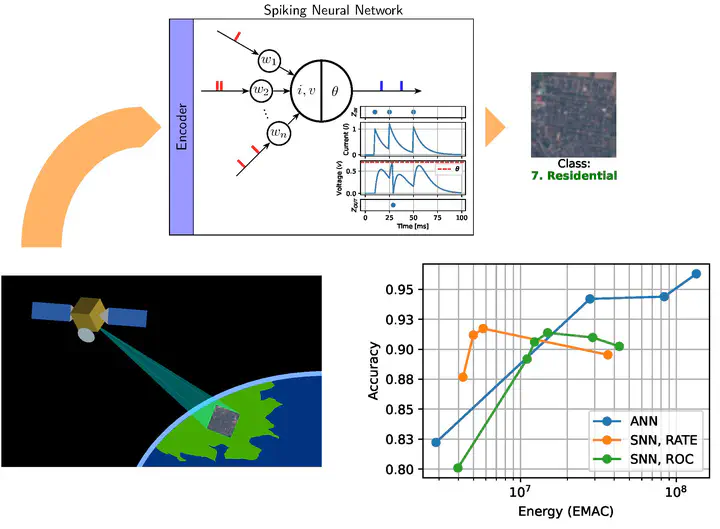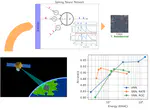Ariadna - Spiking Neural Networks
Investigation of low energy Spiking Neural Networks based on temporal coding for scene classification

This project is carried out in collaboration with the ESA Advanced Concepts Team, as part of the Ariadna initiative.
Spiking Neural Networks (SNN) are characterized by low-power and energy-efficient properties1, due to their brain-inspired architecture, in which neurons communicate by means of discrete spikes. Several neuron models exist, but all of them share a general behavior in which input events are somewhat accumulated along time, increasing an internal state called membrane voltage or potential, mimicking the membrane voltage of biological neurons. Whenever the potential exceeds a certain threshold, a spike is released and the voltage is reset. Differently with respect to traditional Artificial Neural Networks (ANN), computation is performed only at the time a spike is received, making the overall activity inside the network inherently sparse. Moreover, SNN can be implemented on neuromorphic hardware, designed to fully exploit such asynchronous, sparse computation paradigm to achieve solutions capable to outperform those based on ANN in terms of power consumption and energy efficiency, potentially by orders of magnitude. On the other hand, the peculiarities that make SNN so promising make them also harder to train than their ANN counterparts, due to the intrinsically discontinuous nature of the signals flowing inside the network. In fact, no standard training techniques still exist for SNN. Their use in space applications is still limited, and the ability of these models to cope with complex features still awaits a convincing demonstration2.
The aim of this project is to perform a preliminary investigation of the potential benefits of SNN based on temporal coding for onboard Artificial Intelligence (AI) applications, considering the case study of the EuroSAT dataset3, a land use classification task representative of an actual use in Earth Observation. To achieve this goal, state of the art SNN models are to be compared in terms of accuracy and complexity (here considered as the number of synaptic operations, number of spikes per neuron, and others). Proper training algorithms for the SNN models shall be also evaluated and selected. Eventually, the aim is to establish a method to perform hardware-agnostic, relative comparison of the computational load required by different architectures, both SNN and ANN. The results of the analysis will highlight the possible advantages and drawbacks of SNN models compared to ANN, which represent the state of the art for scene classification.
J.K. Eshraghian, et al., “Training Spiking Neural Networks Using Lessons From Deep Learning,” Proceedings of the IEEE, 2023, 111(9): 1016–1054, doi:10.1109/JPROC.2023.3308088. ↩︎
D. Izzo, et al., “Neuromorphic computing and sensing in space,” in Artificial Intelligence for Space: AI4SPACE, 2022, arXiv:2212.05236 [cs.NE]. ↩︎
P. Helber, et al., “EuroSAT: A Novel Dataset and Deep Learning Benchmark for Land Use and Land Cover Classification,” 2019, arXiv:1709.00029 [cs.CV]. ↩︎

